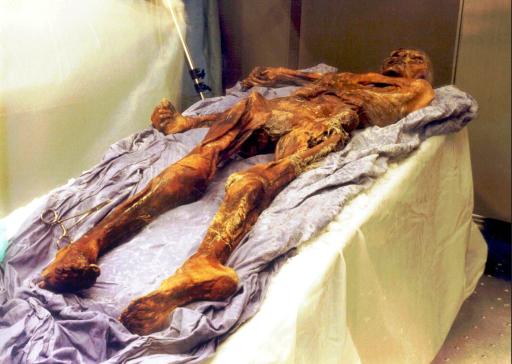Oetzi – what really happened to the 5,30-year-old Ice Man
 OETZI (or Ötzi), the 5,300-year-old Ice Man discovered in the Italian Alps, is back in the news. Oetzi has the oldest blood ever found in a mummy. It’s undergone lots of tests by experts.
OETZI (or Ötzi), the 5,300-year-old Ice Man discovered in the Italian Alps, is back in the news. Oetzi has the oldest blood ever found in a mummy. It’s undergone lots of tests by experts.
The least news is that Oetzi was shot in the back by an arrow and died later.
Experts tell readers of the Journal of the Royal Society Interface, that Oetzi did not die immediately.
In 2006. Franco Rollo, of the University of Camerino, in Marche, Italy, said DNA tests suggested Oestzi was sterile.
This expert says Oetzi’s skin markings were tattoos that possibly pointed to his medial history.
This expert says on the BBC:
Ötzi was a shepherd who, one autumn, was returning to his home village with his animals. When he got there he became involved in some kind of argument or battle. He suffered a severe injury to his chest, fracturing his ribs, but managed to escape. He fled into the mountains and made it to the top, but by then he was exhausted from his injuries. He lay down to rest in a sheltered gully where he died of hypothermia and was buried in ice.
Another says:
Ötzi was attacked and managed to flee. As he ran he was shot in the back with an arrow. He pulled out the arrow shaft but the head remained stuck in his shoulder. He reached the top of the mountains but was now exhausted and weakened from bleeding. He could go no further, lay down and died.
Another expert adds:
Otzi, the Stone Age man whose remains were found in a glacier in the Alps in 1991, was fleeing his home village, and died just a few kilometres from safety.
Another New Scientist article notes:
Ötzi was more likely than most to develop heart disease. He carried one genetic mutation that in modern humans raises the risk of coronary heart disease by 40 per cent, and two others that made him prone to a build-up of fat in the linings of his arteries.
Zink says these findings fit with earlier investigations showing that Ötzi’s major arteries, including his aorta, were all calcified – a sign they were clogged with fatty deposits.
This is how it goes. A body is found in 1991. The remains are stuck in the South Tyrol Museum of Archaeology in Italy. The punters are given a story to jul over. And that’s where the facts end..
2880710
*** FILE *** The 5,300-year-old mummy known as "Oetzi" is seen in this undated photo taken shortly after its arrival in the Archeology Museum in Bolzano, Italy Friday, Jan. 16, 1998. New DNA analysis indicates that a 5,000-year-old mummy found frozen in the Italian Alps may have been sterile _ a hypothesis that would support the theory that he may have been a social outcast, officials said Friday Feb. 3, 2006. Franco Rollo, an anthropologist and ancient DNA specialist, of the University of Camerino, in Marche, Italy, and his team carried out tests on mitochondrial DNA on tissue samples taken from the mummy in 2000 and found two typical mutations that are common among men with reduced sperm mobility, the statement said. (AP Photo/Simone Crepaldi)
Posted: 2nd, May 2012 | In: Reviews Comment (1) | TrackBack | Permalink



